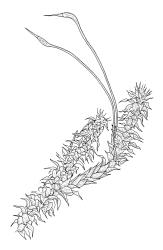- ≡ Hypnum sect. Ptychomnion Hook.f. & Wilson in Wilson, Bot. Antarct. Voy. II (Fl. Nov.-Zel.) Part II, 110 (1854)
Plants bright green, yellow- or brown-green, robust or rarely slender, forming rather loose wefts, mostly on humus or duff. Primary and secondary stems not differentiated, creeping and stiff, irregularly and usually much branched, ascendant, in cross-section as for family. Leaves imbricate or widely spaced, mostly widely spreading, sometimes squarrose, appearing thin, with a broadly elliptic or oblong base, usually abruptly contracted to a rather broad, toothed, and often twisted acumen, occasionally uniformly tapered, variably plicate, little altered when dry; mid laminal cells linear-oblong, thick-walled and porose; cells at insertion forming a pigmented band across the leaf base; alar cells forming a small and weakly defined group. Costae short, double, often indistinct. Paraphyllia absent. Gemmae absent.
Dioicous, mostly phyllodioicous. Perichaetia scattered on ♀ stems, inconspicuous, apparently lacking paraphyses, with inner leaves symmetric, sheathing, broadly oblong-obovate, abruptly tapered to an acumen, which is usually c. ⅓ the total leaf length and with outer leaves often strongly reflexed, enlarging after fertilisation. Male plants usually dwarf and epiphyllic on ♀ plants, occasionally well developed and with scattered gemmiform perigonia. Setae elongate (mostly >20 mm), slender, straight or weakly flexuose, dark red to nearly black in N.Z. species; capsules strongly inclined to pendent, ± cylindric, red-brown, with a weakly developed neck; exothecial cells oblong; annulus obscure; operculum with a very long and slender rostrum, ± ½ to equal the capsule. Exostome teeth weakly shouldered, furrowed and bordered, transversely striate below on outer surface, often baculate near apex, densely trabeculate but otherwise nearly smooth on inner surface; endostome arising from a high basal membrane, with segments well developed and perforate or nearly lacking, and with variably developed cilia. Calyptra enclosing the entire capsule. Spores single-celled, smooth, small.
| 1 | Leaves wide‑spreading to weakly squarrose, with basal plications indistinct or absent, those at shoot apices more crowded than those below; secondary stems usually clearly visible between leaves | P. aciculare |
| 1' | Leaves strongly squarrose, with several well‑defined plications extending from base to ¼–⅓ their length, those at shoot apices not more crowded than below; secondary stems hidden throughout by closely imbricate and sheathing leaves | P. densifolium |
| Category | Number |
|---|---|
| Indigenous (Non-endemic) | 2 |
| Total | 2 |
Ptychomnion is a genus of fewer than eight species, restricted to cool and warm temperate regions of the southern hemisphere. It was isolated in the Ptychomniaceae into a monotypic subfamily Ptychomnioideae by Brotherus (1925) on the basis of large stature, erect-squarrose leaves, longer setae, horizontal and curved capsules, and well-developed peristomes (all relative to the genera placed together in the subfamily Cladomnioideae). The N.Z. representatives are predominantly terrestrial.
One species traditionally placed in Ptychomnion, P. ptychocarpum (Schwägr.) Mitt., a slender and epiphytic South American species, has been segregated recently into the monotypic genus Ptychomniella (Broth.) W.R. Buck, C.J. Cox, A.J. Shaw & Goffinet.




